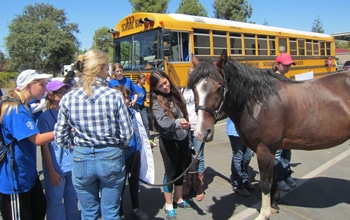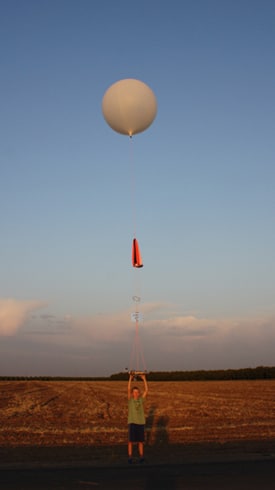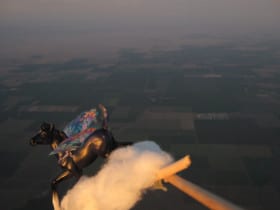Twelve-year-old Taylor Lai has a passion for horses. She’s attended horseback riding summer camps, and has been fortunate to have grown up with horses in the Mount Diablo foothills in California.
“I really want to have my career to do with horses, and I like the idea of being a vet because you get to be around the horses or the animals, and I love animals so much,” said Taylor.
Two years ago she founded her own club for horse lovers with the help of her mother Shanna Gage Lai. This year, she and her mom organized a five-day summer camp for Bay Area fourth through 12th graders to focus primarily on the veterinary field, among other horse-related sciences.
Let’s follow along on the first ever Bay Area Equestrian Club Vet Camp!
Day 1

The BAE school bus
One of the main activities on the first day was a presentation on the anatomy and function of a horse’s gastrointestinal (GI) tract from teeth to tail given by Dr. Jamie Textor of Total Performance Equine.
Campers got to handle real horse teeth and dental equipment (“floats”)! They learned the different parts of the GI tract, from mouth to esophagus to stomach to small intestine to large colon/intestine to rectum to anus and even had a guessing contest about how long a horse’s small intestine is!
Science Talk – gastrointestinal tract: refers to an animal’s digestive system, from the mouth to the anus.
Horse Talk – floats: In domesticated horses, it is very common for their teeth to wear unevenly and develop sharp points and sharp edges that can cut into their jaws or tongue. Floating a horse’s teeth is when the vet or equine dentist takes a long handled rasp and files off any sharp points and edges on the horses teeth. Equine floats are the tools they use.

Teeth floating demonstration using an equine dental float.
So, just how long is a horse’s GI tract? The esophagus is 5 feet → the stomach 1 foot → small intestine ? → and finally, the large intestine is 23 ft. The total length of a horse’s GI tract is 99 feet. (All measurements are approximate.)
1. You don’t need to guess how long a horse’s small intestine is, you can calculate it! Approximately how long is the small intestine?
2. What percentage of a horse’s entire GI tract is make up of the small intestine? Round your answer to the nearest 1%.
Horses evolved as grazing animals, which would roam over the grasslands, consuming relatively small amounts of forage on a more or less steady basis, over a long period of time. This meant the stomach didn’t have to be very big. From the stomach, food moves into the small intestine. The small intestine is only about two inches in diameter.
3. What does it mean, that the small intestine is 2 inches in diameter?
It takes 1 1/2 to 3 days for food to travel through a horse’s digestive system.
4. Express the range of time it takes for food to travel through a horse’s digestive system in hours.
Dr. Textor commented on how excited the campers were to learn; they asked tons of questions, took lots of notes, and loved learning about the horse’s inner workings.”They light up. They’re not limiting themselves. This camp tells them to be exploratory, be brave, don’t stop reaching,” she said.
If you had been one of the campers at Vet Camp, what question would you have for Dr. Textor? Leave your questions in the comment box below and we’ll ask an expert for the answer and post it back in the comment box.
 Day 2
Day 2
After a good nights rest it was back to camp. Along with the opportunity to dissect an eye, heart and an introduction to the art of suturing, campers participated in planning the launch of a horse model into space, attached to a weather balloon!
The students helped build the balloon and a teacher and his 10-year-old son launched it. They began by preparing a tracking device as well as the two cameras they would be flying; they were able to turn one into a time lapse camera. Each camera was pointed outwards from the vehicle, with the ‘flying horse model’ in the foreground.
They hooked up the helium tank, secured the last of the recovery parachute lines, and began filling the balloon. In a few minutes, the balloon was filled and ready to release.
With a quick scan of the sky for low flying aircraft and power lines, they gave a symbolic countdown and with nervous hearts, released the balloon!
Data was collected and the campers learned that the balloon and horse model, complete with wings, went up to 81,000 feet (24,700 meters)!
5. How many miles (km) high did the horse model go? Round your answer to the nearest tenth of a mile (km). (There are 5280 feet in 1 mile.)
During the balloon’s flight, as it rises, it will grow more than 4 times the diameter and up to 83 times the volume measured at launch, until it can’t stretch any more and will burst! The height at which this happens is called the ‘burst altitude’. The burst altitude for the balloon used at camp was 91,000 feet.
6. How much higher could the balloon have gone before bursting?
7. As you will see in the video below, the balloon was launched at 7:25 p.m. in Stockton, CA. Express the launch time in 24-hour time.
To find the balloon, the teacher hiked, crawled, scrambled, and climbed up and down a shrub choked and tree covered hill until, he spotted the parachute and vehicle high in a coastal live oak tree. Planning ahead, he’d brought along an extendable branch trimmer. He shimmied up the tree until he could lean out with the trimmer and snag a dangling parachute line. A little tug, and the whole vehicle dropped out of the tree canopy and onto the ground. Fortunately, the teacher was able to climb down safely!
8. The balloon was recovered at 4:30 a.m. in the Oak forests southwest of Los Gatos. It had gone 65 miles! Express the time the balloon was recovered in 24-hour time.
9. How much time had elapsed between the balloon’s launch and when it was recovered?
There is plenty more that happened during the Bay Area Equestrian Club’s first ever Vet Camp. We’ll share more next week!
Watch video footage shot from on the balloon launch!
1. You don’t need to guess how long a horse’s small intestine is, you can calculate it! Approximately how long is the small intestine?
Answer: 99 – (5 + 1 + 23) = 99 – 29 = 70. A horse’s small intestine is 70 feet long!
2. What percentage of a horse’s entire GI tract is make up of the small intestine? Round your answer to the nearest 1%.
Answer: 70/99 × 100% = .707. Seventy-one percent of a horse’s GI tract is the small intestine!
3. What does it mean, that the small intestine is 2 inches in diameter?
Answer: Diameter refers to the length of a straight line drawn through the centre of a circle that touches both sides. Imagine the small intestine, cut through and looking straight on. It would look like a circle. A two inch diameter tells us how wide across a horse’s small intestine is.
4. Express the range of time it takes for food to travel through a horse’s digestive system in hours.
Answer:
Step 1: There are 24 hours in one day. To find out how many hours are in a day and a half: 1 1/2 days × 24 hours = 36 hours.
Step 2: 3 days × 24 hours = 72 hours. It takes 36 to 72 hours or food to travel through a horse’s digestive system.
5. How many miles (km) high did the horse model go? Round your answer to the nearest tenth of a mile (km). (There are 5280 feet in 1 mile.)
Imperial Answer: 81,000 ÷ 5280 = 15.34. The horse model rose 15.3 miles into the air.
Metric Answer: 24,700 ÷ 1,000 (number of meters in a km) = 24.7 km. The horse model rose 24.7 km into the air.
6. How much higher could the balloon have gone before bursting?
Answer: 91,000 ft – 81,000 ft = 10,000 ft. The balloon could have risen 10,000 more feet before bursting.
7. As you will see in the video below, the balloon was launched at 7:25 p.m. in Stockton, CA. Express the launch time in 24-hour time.
Answer: 19:25.
8. The balloon was recovered at 4:30 a.m. in the Oak forests southwest of Los Gatos! Express the time the balloon was recovered in 24-hour time.
Answer: 04:30.
9. How much time had elapsed between the balloon’s launch and when it was recovered?
Answer:
Step 1: Calculate the elapsed time between 7:25 p.m. and 12:00 a.m. (midnight), this equals 4 hours and 35 minutes.
Step 2: Add this amount to the elapsed time between 12:00 a.m. (midnight) and 4:30 a.m., 4 hours and 35 minutes + 4 hours and 30 minutes = 9 hours and 5 minutes. Nine hours and five minutes had elapsed between the balloon’s launch and when it was recovered.
Click here for Part 2 of Summer Vet Camp!
Common Core:
RI.4.1, RI.5.1 – Basic Geometry terms; Anatomy of a Circle
4.OA.A.3 – Multi-step world problems
4.NF.B.4a – Multiply unit fractions by whole numbers
4.MD.A.2 – Elapsed time: word problems
6.RP.A.3c Find a percent of a quantity as a rate per 100
6.NS.B.2 Fluently divide multi-digit numbers using the standard algorithm.
Photos:
All photos courtesy of the Bay Area Equestrian Club



 Day 2
Day 2




